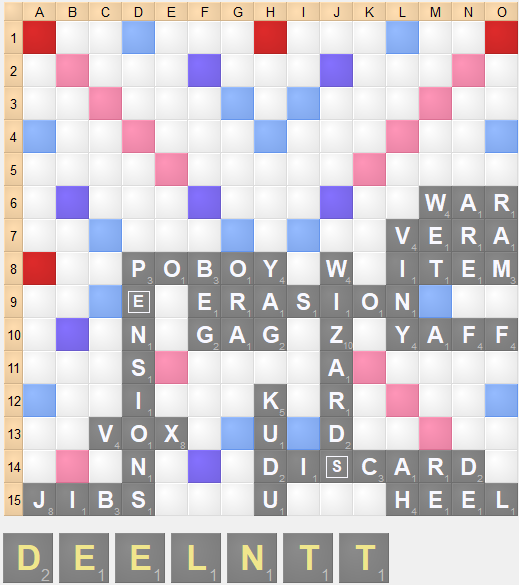
Pool: AACEEEEEGHIIIILLMNNOOOOPQRSTTTUU
You’re up by 44 and turn: it’s going to be hard for your opponent to outrun you by simply scoring, as there really aren’t all that many scoring options possible. Quackle simulation shows that the average score is 20 points with a standard deviation of about 12, indicating that a 44 point lead + turn is quite safe in terms of this position’s future scoring potential.
The major existential threat to your lead is bingos: fortunately, you’re on a board where it is difficult to bingo. Unfortunately, it is also very easy for your opponent to create bingos and bingo lines.
One approach is to outrun these potential bingos. A play like KERNEL/KERNED, RELENT or RETTED scores decently and plays off bad tiles on this board (since the bingo prospects are so bad, tiles like E, N, T, etc. drop in value considerably) in hopes of drawing good tiles (such as the S, H, and Q). Another option is to play TAEL (which sets up the S, but the S is going to score anyway, and can be blocked by row 13 parallels: you can also play the row 13 parallel like NE first to “protect” TAEL).
There are two spots to create bingo lines: one in bottom left quadrant, but more noticeably, bingo line hooks can be created at n5 with plays such as PARE, TARE, HARE, and especially CARE/CRAM. These threats are not only immediate: they are recurring, and your opponent can (and often should) make these plays even without the S in hand, and are very difficult to stop in general. For this reason, a reasonable option is playing TRAM immediately for 6 points, blocking the potential S setup immediately.
But for this same reason, the D is a quite useful tile because of the five letter word DIRAM. This allows you to block many of those setups (all of them except CARE), and prevents a recursive bingo line that can easily overcome your lead. For this reason, the D is a very useful tile to keep: enough so that RELENT becomes a better play than RETTED, and KERNEL is a better play than KERNED.
While KERNEL scores more points, it is also less flexible, keeping 3 consonants and two Ts (with 3 Ts unseen). Thus, RELENT has a higher valuation. Similarly, when you compare RELENT and TAEL, both have a nearly equivalent leave (DT is a trifle better than DENT, but not much) but the VINYLS hook is a slight negative since it introduces an outscoring threat (VINYLS isn’t a threat immediately, but after the CARE/TARE setup, it could easily become one with some other scoring tiles). I slightly prefer RELENT.
It just comes down to the fact that we’re going to have to deal with the n5 setups eventually, and we’re going to have to sacrifice points to do so: even if our opponent makes a 25 point play next turn, that setup is still going to be a priority for turn after turn after turn, and there’s never going to be a good option to block it. Your opponent will almost always make this setup in future turns and you’re going to need to block it. For this reason, it’s best to stop this setup in its tracks and block it immediately by playing TRAM to preemptively kill the potential open flower that will be very difficult to stop.
